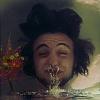As Stainless mentions, there are several factors to consider.
All are due to various types of friction.
Once the object is moving, however, static friction doesn't come into play. Static friction is applicable only when an object transitions from a rest state with respect to the surface, to motion with respect to that surface.
Aerodynamic Drag friction - due to the friction of air or water over the surface of the object - proportional to the profile area of the object in the direction of its velocity, and proportional to the magnitude of the relative velocity between the vehicle and the fluid.
Rolling friction - proportional to normal force between an object and a surface. The coefficient of rolling friction (or rolling resistance) is complicated and shows variations dependent on speed, surface, torque, etc.
Sliding friction - similar to rolling friction, it's proportional to the normal force. The coefficient of sliding friction is smaller in value than the coefficient of rolling friction under the same circumstances.
I would suggest modeling a tank with rolling friction when there is no slip between the tracks and the surface. When the surface is slippery, change the coefficient to sliding. If brakes cause the tracks to "lock," switch to sliding friction.
Though largely independent of speed, be sure to apply rolling/sliding friction only when speed is greater than 0. To avoid jittering when velocity is decreasing (no drive from the engine) - set the velocity to 0 when the calculated velocity is smaller than some epsilon (small value). Because rolling/sliding friction is always in the opposite direction of velocity, if that test is not made, friction will appear to drive small velocities in reverse, then drive that small velocity forward, then reverse, etc., because the calculations are discrete and never actually equal 0.
Listed separately as they apply to the torque delivered to the wheels (not applied as forces to the chassis,) there are various forms of internal resistance, assuming a model of an engine driving a transmission, the transmission driving a differential, the differential driving axles connected to wheels.
Engine efficiency - due to internal friction, commonly modeled as decreasing efficiency with engine RPM.
Transmission efficiency - commonly modeled as a constant plus a decreasing efficiency proportional to gear-ratio.
Differential efficiency - commonly modeled as proportional to axle RPM - i.e., engine RPM * transmission gear-ratio.
drive-wheel-torque = engine-torque-at-current-RPM * engine-efficiency * gear-ratio * transmission-efficiency * differential-ratio * differential-efficiency
Depending on how simply you want to simulate those internal factors, you can just decrease the drive force proportional to velocity or velocity-squared, whichever seems to suit you better.
As a result of all the factors discussed, the speed of the vehicle is limited because aerodynamic drag increases with speed, and the torque delivered to the wheels decreases with velocity (or velocity-squared). At some speed, the drive torque is just sufficient to overcome the friction forces and there is no net force on the chassis. With no net force on the chassis, the velocity remains constant.










